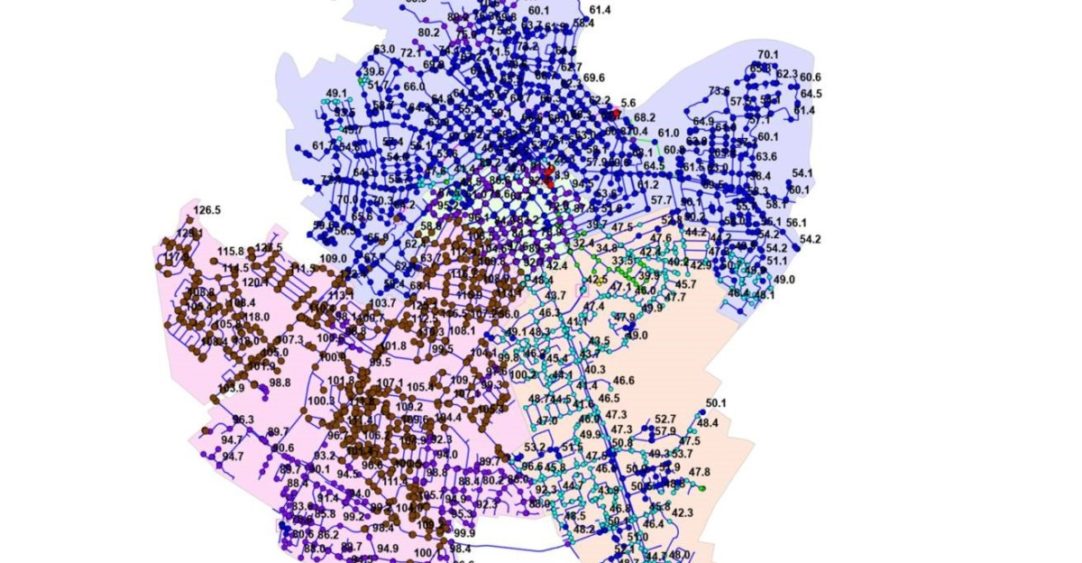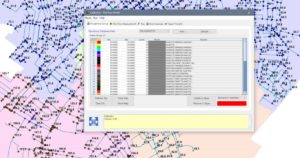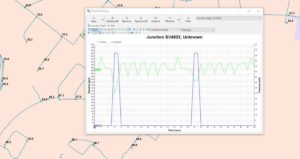
Water Modeling Analyses
A hydraulic water model is a powerful tool that can aid in development impact assessment, master planning, fire flow analysis, and emergency response occurrences. Through the help of specialized software, such as InfoWater Pro, a community’s distribution system can be modeled as a network that includes many attributes such as diameter and length of pipes, pumps, valves, valve operation, storage tanks, etc. However, before a water model can be effectively used to perform various analyses, these details need to be input and then the model calibrated with actual field conditions.
Calibrating for an Accurate Model

The first step to utilizing a water model to its full capability is to calibrate the model so it mirrors actual operation in real time. A calibrated model should provide an overview of how a distribution system operates at any given time throughout the day. To ensure the accuracy; static, dynamic, and extended period calibration exercises need to be applied to the system. In addition, a diurnal curve of the community’s water consumption should be established and integrated into the model. This gives an accurate representation of when consumption peaks or drops throughout a 24-hour day. Calibration can be completed by utilizing data from two hydrant flow and residual pressure testing. Not every hydrant in the system needs to be tested in order to establish an accurate model. A number of hydrants in each pressure zone of a system can be used to calibrate a model. The results from these strategically selected hydrants are compared to the model to determine what changes need to be made to better reflect what’s happening in the system. With the hydrant calibration complete, system settings provided by a community (i.e. pump operation set points, typical tank levels, pressure reducing valve settings) further aids in creating an accurate model.
Development Impact Assessment
One of the benefits of the model is the capability to evaluate the impacts of a proposed development(s) on the existing system. When one or more developments are proposed to connect to a system, how do we know the existing infrastructure can adequately provide flow and pressure to those future customers? When reviewing the model in this type of assessment, we not only have to consider if flow and pressure can be provided to the future customers, but also the affects to the existing customers. Using the calibrated water model, the pipe headlosses, velocities, minimum pressures, and flow can be identified. For example, if a new, high-water demand development results in a large amount of headloss in the area, improvements to the system may be necessary. The model identifies where major headloss and high velocities occur so that the pipe can be identified, and proposed improvements established.
Fire Flow Analysis

While fire flow analysis could be lumped into the assessment of proposed developments, one of the most common uses for water modeling is determining available fire flows throughout a community’s system. Reviewing available fire flow is important for all communities, however, fire flow demands are typically the largest demands in the system which can have dramatic impacts on operation of the system. A water model can identify fire flow deficiencies in the system and evaluate system improvements needed to enhance fire flow, such as which pipes should be upsized. The model can also be used to help prioritize improvements by determining which improvements will have the most significant hydraulic benefits to the system. This aspect of fire flow analysis can start establishing the early workings of a master plan for a community.
Master Planning
Since we know that a model can be used for analyzing one or more developments and look into fire flow demands… can we use the model for planning, 5, 10, 20 years into the future? Most definitely! Because the calibrated water model realistically simulates how the existing distribution system is operating, the model can assess how facilities will perform in the future under a variety of future scenarios. The model enables us to make reliable recommendations for capital improvement projects for the near term and also into the future. The projects identified could vary from pipe replacement and installation, installation of major valves, pump station, or needed tanks. The model can also aid in predicting pump operational changes necessary as the distribution system continues to grow and change.
Emergency Response
We have a fully calibrated water model. We’re continuing to assess proposed developments and fire flow. We’ve established a master plan that we can use and periodically update for the next 20 years! Now what? Well, hopefully we never have to cross this bridge, but the model can be used for emergencies that can unfortunately occur. Say we have a major rainstorm that blows through town, the runoff from the storm has exposed a major line in the system. How long can this pipe be isolated and out of service so the exposed pipe can be addressed? With the help of a water model, we can identify how long this pipe can be out of service before ramifications are seen in the system.
This is a continuation of our series on Water Models, the previous post focused on Benefits of a Water Model. If you have a specific topic you’d like our team of engineers and experts to cover, email info@ssr-inc.com.








